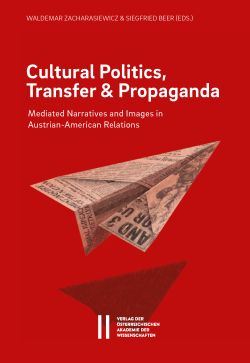
CULTURAL POLITICS, TRANSFER, AND PROPAGANDA, pp. 33-58, 2021/12/16
Mediated Narratives and Images in Austrian-American Relations
The interdisciplinary collection contains 16 essays by scholars from literary and cultural studies, by sociologists, historians, musicologists, art historians and media experts. Following the introduction to the key issues in cultural politics and propaganda and a synopsis of the essays, an article surveys the reciprocal perception of Austria and the USA from the 18th century onwards. The following essays analyze various historical phases in the complex relationship between Austria (and Central Europe) and the USA. Several essays survey the strategies used to promote Austrian tourism and contrast them with advertisements for American sights, and document the implementation of aid programs for the impoverished societies in Austria in the aftermath of World War One. There follow articles that discuss the role of exiled Austrians in the dissemination of a positive image of Austria and a favorable view of the USA, while two contributions are devoted to the misrepresentation of significant individuals active in Austria in the interwar years. Special attention is then paid to the role of the Marshall Plan in economic reconstruction in Austria and Western Europe, and to the promotion of liberal democracy in the media during the Cold War. The impact of transatlantic exchange programs for scholars and scientists in the countries of Europe under Soviet influence is also considered. The wide range of essays concludes with critical perspectives on political phenomena, such as the apparently exaggerated role of Austrian resistance fighters in the liberation of the country from the Nazi tyranny in 1945, and on the controversy over Dr. Kurt Waldheim as reflected in popular music in the 1980s. The transfer of new concepts of contemporary art in museums and of contrasted cinematic genres resulting in a merger is illustrated in the final two essays.
…
Der Sammelband mit Beiträgen von Literatur- und KulturwissenschaftlerInnen, SoziologInnen, ZeithistorikerInnen, MusikwissenschaftlerInnen und MedienexpertInnen, sowie KunsthistorikerInnen, umfasst 16 Aufsätze. Nach der ausführlichen Einleitung, die zentrale Aspekte in der Kulturpolitik und in der Werbung erörtert und einen Überblick über die Essays gibt, skizziert ein Artikel die Entwicklung der Wahrnehmung Österreichs und Mitteleuropas in den USA und der reziproken kollektiven Bilder Amerikas im Herzen Europas seit dem 18. Jhdt. Verschiedene Phasen der komplexen transatlantischen Beziehungen werden dann, im Wesentlichen in chronologischer Folge, analysiert, wobei zwei Aufsätze der Entfaltung der Werbung für den Fremdenverkehr gewidmet sind. Weitere Beiträge befassen sich mit den Hilfsprogrammen für die notleidende Bevölkerung Österreich nach dem 1. Weltkrieg und mit den großzügigen Hilfsprogrammen nach dem 2. Weltkrieg. Auch die Rolle von Exilanten als Vermittler eines positiven Bildes Österreichs in den USA und eines Idealbildes der USA als demokratisches Musterland kommt zur Sprache. Die Bedeutung des Marshall Plans für den Wiederaufbau Österreichs und Westeuropas und die Propaganda in den Medien im Kalten Krieg werden in mehreren Essays dokumentiert. Weitere Beiträge behandeln verfälschende Projektionen von Profilen einzelner Persönlichkeiten aus der Zwischenkriegszeit und erörtern politische Phänomene, wie die übertriebene Darstellung des Beitrags österreichischer Widerstandskämpfer bei der Befreiung von der Nazi Diktatur und die sich in der Populärmusik spiegelnde Kontroverse um Dr. Kurt Waldheim. Schließlich analysieren Essays auch den Transfer von Ideen und Konzepten zur zeitgenössischen Kunst und ihrer musealen Darstellung sowie die Verknüpfung von Filmgenres (Heimatfilm und Western) im transatlantischen Austausch.